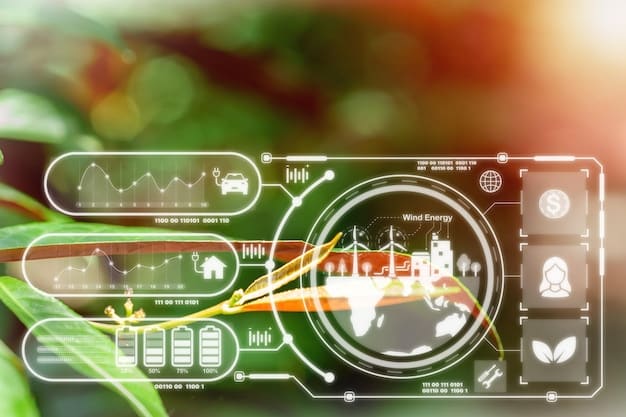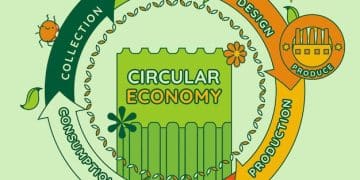Calculate & Reduce Your Carbon Footprint by 10% in 3 Months

Understanding how to calculate your carbon footprint and actively reducing it by 10% within three months primarily involves assessing your daily resource consumption, identifying key emission sources, and implementing targeted behavioral changes for a measurable environmental impact.
Embarking on the journey to understand and reduce our environmental impact is a crucial step towards a more sustainable future. This guide will delve into how to calculate your carbon footprint and reduce it by 10% in 3 months, providing actionable insights and strategies that empower individuals and households to make a tangible difference. It’s an accessible challenge, one that begins with awareness and culminates in positive change for our planet.
Understanding Your Carbon Footprint: The Baseline
Before any reduction can occur, it’s essential to grasp what a carbon footprint truly represents. It’s the total amount of greenhouse gases (GHGs) – primarily carbon dioxide (CO2) – generated by our actions. This includes emissions from electricity use, transportation, food consumption, and the materials we buy. Calculating this baseline is the critical first step in setting achievable reduction goals, providing a clear picture of where your emissions originate.
Many people underestimate the sheer diversity of sources contributing to their carbon footprint. While obvious culprits like driving and flying come to mind, less apparent factors, such as the energy consumed to produce and transport your food or the waste generated by your household, also play a significant role. This holistic view is necessary for a comprehensive assessment, enabling more effective strategies for reduction across all facets of daily life.
Components of Your Carbon Footprint
A typical personal carbon footprint is often broken down into several core categories. Understanding these components is vital for accurate calculation and targeted reduction efforts. Each area of consumption offers unique opportunities to minimize environmental impact, from the energy powering your home to the choices you make at the grocery store.
- Home Energy: Includes electricity, natural gas, and heating oil used for lighting, heating, cooling, and appliances.
- Transportation: Encompasses emissions from personal vehicles, public transport, and air travel.
- Food: Accounts for the emissions associated with food production, processing, transportation, and waste.
- Goods & Services: Covers the carbon embedded in the products we purchase and the services we use, from clothing to electronics.
- Waste: Emissions generated from landfill decomposition and waste treatment processes.
Why Calculate Your Footprint?
Calculating your carbon footprint isn’t just an academic exercise; it’s a powerful tool for personal environmental stewardship. It transforms abstract concepts of climate change into concrete, quantifiable data specific to your lifestyle. This data then empowers you to identify your highest-impact areas, allowing you to prioritize efforts for maximum effectiveness.
The process itself can be incredibly eye-opening, revealing surprising insights into your consumption patterns. For instance, you might discover that your dietary choices have a larger impact than your daily commute, prompting a shift in focus for your reduction strategy. Without this foundational understanding, efforts to live more sustainably might be haphazard and less impactful.
Tools and Methods for Carbon Footprint Calculation
Fortunately, you don’t need a degree in environmental science to calculate your carbon footprint. A range of online calculators and methodologies exist, varying in complexity and the depth of data they require. The key is to choose a tool that balances accuracy with ease of use, ensuring you can complete the assessment without feeling overwhelmed.
Most calculators will ask for information related to your home energy bills, mileage driven, public transit use, and other daily habits. While some tools provide a quick estimate based on general averages, others delve into more precise details, like the type of vehicle you drive or your dietary preferences. For a 10% reduction goal, a reasonably detailed calculation is advisable.
Recommended Online Calculators
Several reputable organizations offer free, user-friendly carbon footprint calculators. These tools are designed to provide a comprehensive estimate of your emissions, often breaking down the footprint into different categories and offering insights into potential reduction areas. It’s often beneficial to try a couple of different calculators to get a broader perspective, noting any discrepancies and understanding their underlying methodologies.
- EPA Carbon Footprint Calculator (US Environmental Protection Agency): Known for being thorough and based on US data, it covers home energy, transportation, waste, and more.
- The Nature Conservancy Carbon Footprint Calculator: This tool offers a straightforward approach, asking relevant questions about your lifestyle without being overly intrusive.
- CoolClimate Network (UC Berkeley): Provides a more detailed breakdown, allowing users to input specific data points like utility bill amounts and travel logs for greater accuracy.
Gathering Your Data: What You’ll Need
To use these calculators effectively, you’ll need to gather some basic information about your household and lifestyle. The more accurate your input, the more precise your carbon footprint estimate will be. Taking the time to collect this data upfront will streamline the calculation process and ensure a reliable baseline from which to measure your 10% reduction.
Look for recent utility bills (electricity, natural gas), records of vehicle mileage or fuel purchases, and a general understanding of your dietary habits and purchasing patterns. Even estimates can be useful if precise figures aren’t immediately available, but always aim for the most accurate data possible. Remember, this initial investment in data collection pays dividends in the effectiveness of your reduction strategy.

Setting Your 10% Reduction Goal in 3 Months
Once you have your baseline carbon footprint, the next step is to set your 10% reduction target. This is a significant, yet achievable, goal within a three-month timeframe. The beauty of a percentage-based target is its adaptability to any starting point, making it relevant whether your footprint is large or small. Focus on realistic and consistent changes rather than drastic, unsustainable overhauls.
Breaking down a 10% reduction over three months means aiming for roughly 3.3% reduction each month. This can be less daunting. For example, if your annual footprint is 15 tons of CO2, a 10% reduction is 1.5 tons annually, or 0.125 tons per month. This tangible target provides a clear aspiration and motivates consistent effort. It’s about finding small, repeatable actions that accumulate into a substantial positive impact.
Identifying High-Impact Areas for Reduction
A key insight from your carbon footprint calculation will be the identification of your highest-impact areas. These are the categories contributing most significantly to your overall emissions. Focusing your initial reduction efforts here will yield the most substantial results towards your 10% goal, making your efforts highly efficient and effective.
For many households, home energy consumption and transportation are the largest contributors. However, dietary choices, particularly meat consumption, can also have a surprisingly large footprint. Your personalized calculation will pinpoint exactly where to concentrate your efforts, ensuring that every action you take is moving you closer to your sustainability target.
Strategies for Home Energy Reduction
Reducing home energy consumption is often one of the most effective ways to lower your carbon footprint. Even small changes in daily habits can lead to significant savings on your utility bills and a measurable reduction in greenhouse gas emissions. The three-month timeline allows for implementing both immediate behavioral adjustments and potentially minor home improvements.
- Optimize Heating & Cooling: Adjust thermostats a few degrees warmer in summer and cooler in winter. Use programmable or smart thermostats to automate temperature changes.
- Unplug “Phantom Loads”: Many electronic devices consume electricity even when turned off (e.g., phone chargers, TVs, computers). Use power strips and switch them off when not in use.
- Switch to LED Lighting: LEDs are significantly more energy-efficient and long-lasting than traditional incandescent bulbs, offering immediate savings and reduced energy demand.
- Air Seal & Insulate: Check for drafts around windows and doors and seal them. Adding insulation to attics can drastically improve energy efficiency, though this might be a longer-term project.
Transportation Emission Reduction Tactics
Transportation is another major contributor to carbon footprints. Reducing travel, switching to more efficient modes, and optimizing vehicle use are all powerful strategies. Over three months, significant changes can be made, from adjusting commuting habits to planning more efficient travel routes for errands.
Consider the cumulative effect of small changes. Opting to walk or bike for short distances even a couple of times a week adds up over time. If public transport is an option, making that switch for part of your commute can dramatically cut down on individual vehicle emissions. Even for longer trips, exploring carpooling possibilities can share the environmental burden.
- Drive Less: Consolidate errands, walk, bike, or use public transport for shorter trips.
- Maintain Your Vehicle: Proper tire inflation and regular maintenance improve fuel efficiency.
- Consider Carpooling: Share rides for commuting or other regular journeys.
- Fly Less: For long-distance travel, explore alternatives like trains where feasible, or reduce discretionary air travel.
Dietary and Consumption Changes for Lower Emissions
What we eat and what we buy significantly impact our carbon footprint. The production, processing, transportation, and disposal of food items and consumer goods all contribute to greenhouse gas emissions. Over three months, conscious choices in these areas can yield substantial reductions, making your lifestyle more harmonious with planetary boundaries.
The concept of “food miles” and understanding the energy embedded in consumer products becomes critical here. Opting for locally sourced produce, choosing plant-based meals more frequently, and extending the life of your purchases are all effective strategies. It’s about mindful consumption, prioritizing need over want, and supporting sustainable practices.
Reducing Food-Related Emissions
The adage “you are what you eat” extends to your carbon footprint. Livestock farming, particularly for beef, has a substantial environmental impact due to methane emissions and land use. Shifting dietary patterns, even incrementally, can significantly reduce your food-related emissions without drastic sacrifices.
Consider incorporating more plant-based meals into your weekly menu. Experiment with new recipes that feature legumes, grains, fruits, and vegetables as their main components. Reducing food waste is another crucial aspect; planning meals, storing food properly, and composting scraps prevent methane emissions from landfills. Every conscious food choice makes a difference.
- Eat Less Meat (Especially Beef): Incorporate more plant-based meals into your diet, or opt for poultry and fish over red meat.
- Buy Local & Seasonal: Reduce “food miles” by purchasing produce from local farmers’ markets.
- Reduce Food Waste: Plan meals, store food properly, use leftovers, and compost food scraps.
- Choose Sustainable Seafood: Opt for seafood certified as sustainably sourced to minimize impact on marine ecosystems.
Mindful Consumption of Goods & Services
Beyond food, the products we consume and the services we use carry an embedded carbon footprint from their production, distribution, and eventual disposal. Embracing a philosophy of mindful consumption – distinguishing between needs and wants – can dramatically reduce this aspect of your footprint. The “reduce, reuse, recycle” mantra is more relevant than ever.
Before purchasing something new, consider if it can be borrowed, repaired, or bought used. Prioritize durability and longevity in products. When discarding items, think about donation or recycling before resorting to the landfill. These habits, cultivated over three months, establish a more sustainable approach to material consumption that extends far beyond the initial timeframe.
- Reduce, Reuse, Recycle: Prioritize reducing consumption, reusing items, and then recycling what cannot be reused.
- Buy Secondhand: Purchase clothing, furniture, and electronics used to extend their lifespan and reduce demand for new production.
- Choose Durable Goods: Invest in high-quality items designed to last, reducing the need for frequent replacements.
- Support Sustainable Brands: Opt for companies committed to ethical sourcing, sustainable production, and reduced packaging.
Tracking Progress and Staying Motivated Over 3 Months
Achieving a 10% carbon footprint reduction in three months requires consistent effort and the ability to track your progress. Just as you measured your baseline, you’ll need mechanisms to monitor the impact of your changes. This feedback loop is crucial for staying motivated, identifying what works, and making adjustments where necessary.
Consider dedicating a specific day each month to re-evaluate your consumption habits and re-calculate parts of your footprint. Perhaps review your electricity usage by checking your utility meter, or tally your car mileage. Seeing tangible results, even small ones, can provide the encouragement needed to maintain your new, greener habits.
Monthly Check-ins and Adjustments
The three-month period is short enough to feel manageable, but long enough to see trends. Schedule regular check-ins – perhaps at the end of each month – to assess your progress. Have your electricity bills decreased? Are you driving less? Can you identify new opportunities for reduction that you might have overlooked initially? This iterative process is key to success.
Don’t be discouraged if some areas show less improvement than others. The goal is consistent effort and incremental change. If one strategy isn’t yielding the desired results, pivot and try another. For instance, if cutting down on driving proves difficult, compensate by being more rigorous with home energy savings or dietary changes. Flexibility and adaptability are your allies in this journey.

Celebrating Small Wins and Staying Accountable
A personal sustainability challenge, like a 10% carbon footprint reduction, benefits greatly from positive reinforcement. Celebrate your small wins along the way, whether it’s a noticeably lower energy bill, a week dominated by plant-based meals, or successfully biking to work. Acknowledging these achievements helps build momentum and reinforces positive behaviors.
Consider involving family or housemates in your goal, making it a shared challenge. This provides an additional layer of accountability and support. Discussing progress, sharing tips, and collaboratively brainstorming new ideas can make the journey more engaging and increase the likelihood of achieving your 10% target. Remember, every individual choice contributes to a collective impact.
Beyond 10%: Sustaining Your Reduction Efforts
Achieving a 10% reduction in three months is a significant milestone, but it’s important to view it as a stepping stone rather than a finish line. The habits and awareness you develop during this period are the foundation for ongoing, sustainable living. The ultimate goal is to embed these low-carbon practices into your everyday routine, making them second nature.
Many of the strategies employed for the initial 10% reduction are not one-off actions but lifestyle adjustments. Continuing to monitor your energy consumption, making conscious food choices, and opting for sustainable transportation will yield even greater long-term benefits. The momentum gained in these three months can propel you towards even more ambitious environmental goals.
Establishing Long-Term Sustainable Habits
Think about how your improved habits can become permanent fixtures in your life. Perhaps you discover a newfound enjoyment in cycling, or your plant-based meal experiments introduce you to delicious new recipes. Building these practices into your regular routine minimizes the effort required to maintain a lower carbon footprint, making sustainability effortless over time.
Consider deeper dives into areas like renewable energy for your home, investing in highly energy-efficient appliances, or advocating for sustainable policies in your community. Small personal changes are powerful, but their impact can be magnified when combined with broader systemic shifts. Your journey starts with 10%, but it can inspire a ripple effect.
Advocacy and Community Involvement
Personal carbon footprint reduction is crucial, but it’s only part of the solution. To address climate change on a larger scale, we also need systemic change. Once you’ve successfully reduced your own footprint, you’ll have firsthand experience and a credible voice to share your journey and encourage others.
Consider engaging with local environmental groups, participating in community sustainability initiatives, or simply sharing your tips with friends and family. Advocating for policy changes that support renewable energy, sustainable transportation, and waste reduction can amplify your individual efforts. Collective action, driven by informed individuals, is essential for a greener future.
| Key Action | Brief Description |
|---|---|
| 📊 Calculate Baseline | Use online tools like EPA or TNC to get a clear carbon footprint starting point. Identify main emission sources. |
| 💡 Home Energy Efficiency | Optimize thermostat settings, unplug electronics, switch to LED lighting, and consider minor draft sealing. |
| 🚗 Sustainable Transport | Reduce driving, use public transit, bike/walk for short distances, and carpool more often. |
| 🍎 Conscious Consumption | Incorporate more plant-based meals, reduce food waste, buy local, and choose secondhand/durable goods. |
Frequently Asked Questions
A carbon footprint measures the total greenhouse gas emissions caused directly and indirectly by an individual, organization, event, or product. Reducing it is crucial because these gases trap heat in the atmosphere, contributing to global warming and climate change, which affects ecosystems, weather patterns, and human well-being globally.
Online carbon footprint calculators offer good estimates based on the data you provide. Their accuracy depends on the level of detail you input and the methodology used by the calculator. While they may not be perfect, they provide a valuable starting point for understanding your impact and identifying areas for reduction.
Yes, a 10% reduction in three months is an ambitious yet realistic goal for most individuals. Significant progress can be made by focusing on high-impact areas like home energy, transportation, and dietary changes. Consistent effort and awareness of daily habits are key to achieving this target within the timeframe.
Some of the easiest ways to start include adjusting your thermostat a few degrees, unplugging electronics when not in use, reducing discretionary driving by walking or biking for short trips, and incorporating more plant-based meals into your diet. These small, consistent changes accumulate quickly.
Beyond personal actions, you can contribute by recycling diligently, supporting sustainable businesses, advocating for climate-friendly policies, engaging in community green initiatives, and encouraging friends and family to adopt sustainable habits. Collective action strengthens the overall impact on emission reduction.
Conclusion
Embarking on the journey to calculate your carbon footprint and reduce it by 10% in three months is a powerful step towards personal and planetary well-being. This comprehensive guide has provided the framework, tools, and strategies necessary to achieve this tangible goal. From understanding your emissions baseline to implementing targeted changes in home energy, transportation, and consumption habits, every action contributes to a larger positive impact. The transformation isn’t just about numbers; it’s about fostering a deeper connection to our environment and becoming a more conscious global citizen. By embracing this challenge, you not only contribute to a healthier planet but also inspire others to join the crucial movement towards a sustainable future.





